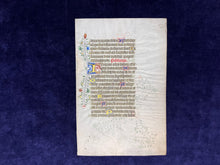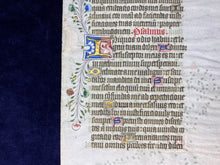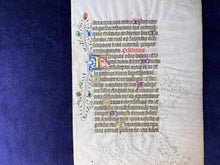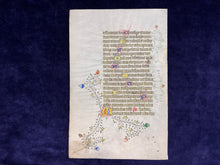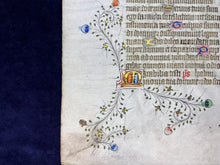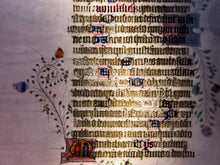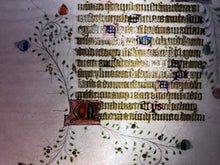
Netherlands, possibly made for commercial export to England, ca. 1450 (230 x 150 mm). Latin. 20 lines of Gothic textualis from Psalter. Single column with one 3-line illuminated initial and one 2-line illuminated initial, both with floral spray embellishments in to margins. Alternating shell-gold and blue initials with alternating red and blue pinwork. Ruled in pink. Improperly mixed ink has burned several lines of letters.
The feathery penwork in the margins, the blue flowers, and the detailed pink and blue illumination around the shell-gold initial are all unmistakeable features of a Dutch illustrator at work. Whether this manuscript was intended to remain in the Netherlands or destined for export to the Dutch-hungry English commercial trade is uncertain.
The Manuscript:
What is certain is that at the time of production the manuscript which this leaf formed a part was a high-end luxury production. The script is a particularly high-end Gothic textualis with hairline hooks over the letter I, quadrata-level diamond-shaped ends on minims, and small extra strokes embellishing the ornate letterforms.
A production fault, however, produces a subtle yet interesting defect, which is not entirely uncommon in medieval manuscripts. The iron gall ink has been improperly mixed and has burned the letters through in some cases, leaving a delicate lattice of parchment. Before the 12th century, carbon based ink was commonly used for manuscripts. This ink appears jet black (though sometimes watery) and rested on top of the parchment. Because of its chemistry, it flakes off somewhat easily. As Gothic script became more popular, so did a new type of ink: iron gall. Produced using iron, the tannins from soaked oak galls, and a bit of gum arabic, the color produced was more of a brown-black or blue/purple black. This ink did not just rest on top of the parchment, but burnt into it. Sometimes the scribe mixed an overly acidic batch of iron gall and over the course of time, the ink corroded the parchment in shape of the letters it formed.
Provenance: Christie's (May 20-23, 1997, The sale of the Kasteel van Rumbeke, issue 2333, lot 2743.







